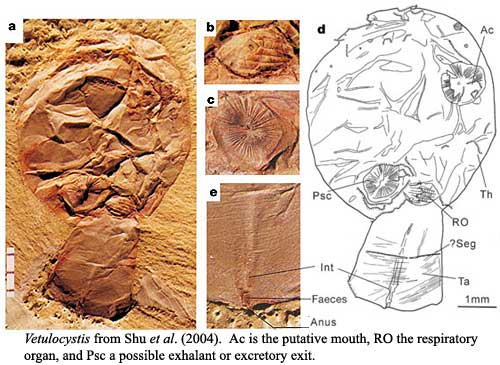|
|
Vetulocystidae |
| Deuterostomia |
Vetulocystidae |
Vetulocystidae
 The Vetulocystidae are a very recently described family of two species from the Chengjiang Lagerstatte of the Lower Cambrian of China. Shu et al., 2004. The authors interpreted them as an anatomical link between the Vetulicolia on one hand and the homalozoans on the other. Like Vetulicolia, they have a distinctly bipartite body plan. The anterior section is globular and bag-like. The posterior tail is truncated -- in Vetulocystis catenata it is broad and expands posteriorly, in Dianchicystis jianshanensis it is tapering. Weakly developed furrows crossing the tail were regarded as segment boundaries like those of Vetulicolia, but this should be regarded as far from definite.
The Vetulocystidae are a very recently described family of two species from the Chengjiang Lagerstatte of the Lower Cambrian of China. Shu et al., 2004. The authors interpreted them as an anatomical link between the Vetulicolia on one hand and the homalozoans on the other. Like Vetulicolia, they have a distinctly bipartite body plan. The anterior section is globular and bag-like. The posterior tail is truncated -- in Vetulocystis catenata it is broad and expands posteriorly, in Dianchicystis jianshanensis it is tapering. Weakly developed furrows crossing the tail were regarded as segment boundaries like those of Vetulicolia, but this should be regarded as far from definite.
Three prominent openings are present on the anterior part (the "theca"). Two cone-shaped orifices are present in the right antero-dorsal and left postero-dorsal quadrants which the authors interpreted respectively as the mouth and anus. A right postero-dorsal lenticular structure with prominent ridges was interpreted as a respiratory organ, and at least one specimen indicates a lamellate structure to this suggesting gills. The specimens are irregularly wrinkled, indicating that the cuticle was not sclerotised and there was no stereom.
The superficial similarity of these creatures to Stylophora is readily noticeable, more specifically to Jefferies' 1986) reconstruction of cornutes. Both show a right anterior mouth and posterior gills, with a posterior tail. The Vetulocystidae therefore supply corroborating evidence for this reconstruction. The tail of Vetulocystis also preserves a median tubular structure that Shu et al. suggested might be an intestine, though they admit that this is inconsistent with identification of the posterior cone as an anus. The tail structure may represent a notochord-like organ, which would also be consistent with Jefferies' Stylophora reconstruction.
The Vetulocystidae probably led sedentary lives on the sea-floor as filter-feeders drawing water into the mouth and expelling it through the anus or gills. The function of the tail is difficult to imagine - it seems too short and the wrong shape to function well as a propulsive organ nor does it resemble a holdfast. Perhaps it was used to dig the animal into the sediment thanks to David Marjanovic for suggesting this).
© Christopher Taylor, CT050827.
page uploaded ATW050823
 The Vetulocystidae are a very recently described family of two species from the Chengjiang Lagerstatte of the Lower Cambrian of China. Shu et al., 2004. The authors interpreted them as an anatomical link between the Vetulicolia on one hand and the homalozoans on the other. Like Vetulicolia, they have a distinctly bipartite body plan. The anterior section is globular and bag-like. The posterior tail is truncated -- in Vetulocystis catenata it is broad and expands posteriorly, in Dianchicystis jianshanensis it is tapering. Weakly developed furrows crossing the tail were regarded as segment boundaries like those of Vetulicolia, but this should be regarded as far from definite.
The Vetulocystidae are a very recently described family of two species from the Chengjiang Lagerstatte of the Lower Cambrian of China. Shu et al., 2004. The authors interpreted them as an anatomical link between the Vetulicolia on one hand and the homalozoans on the other. Like Vetulicolia, they have a distinctly bipartite body plan. The anterior section is globular and bag-like. The posterior tail is truncated -- in Vetulocystis catenata it is broad and expands posteriorly, in Dianchicystis jianshanensis it is tapering. Weakly developed furrows crossing the tail were regarded as segment boundaries like those of Vetulicolia, but this should be regarded as far from definite.